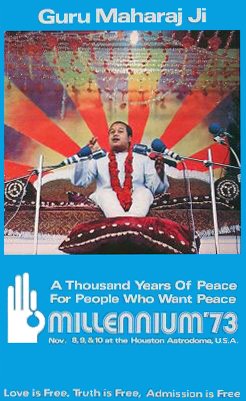
Millennium '73 was a three-day festival held on November 8–10, 1973 at the Astrodome in Houston, Texas, United States, by the Divine Light Mission (DLM). It featured Prem Rawat, then known as Guru Maharaj Ji, a 15-year-old guru and the leader of a fast-growing new religious movement.[1] Organizers billed the festival as the most significant event in human history which would usher in a thousand years of peace.[2][3]
The festival's official schedule described the three evening addresses by Guru Maharaj Ji as the highlights of the event.[4] Big-band music, rock bands, religious songs, choral works, a dance performance and speeches by other DLM leaders filled the program from noon to 10 pm. Media events included press conferences and an impromptu debate.
Millennium '73 received wide publicity. Rennie Davis, a prominent anti-war activist and member of the Chicago Seven, helped draw attention to the event as a spokesman for the DLM. Notable journalists attended, some of them acquaintances of Davis from the New Left. It was later described by some scholars and journalists as among the major events of 1973 and the 1970s, the high point of Guru Maharaj Ji's popularity, and the most important development in the American DLM's history.
Attendance was estimated from 10,000 to 35,000, compared to the projected 100,000. Many scholars and journalists generally depicted the event as a disappointment. That, along with other factors including a large debt, led to changes in the DLM's structure, management and message. The following year the movement split into branches headed by Maharaj Ji in the West, and his mother and brother Bal Bhagwan Ji in India.
- ^ Larson 1982, p. 205
- ^ Galanter 1989, p. 24
- ^ Levine 1974
- ^ Cite error: The named reference
And It Is Divine 1973was invoked but never defined (see the help page).
